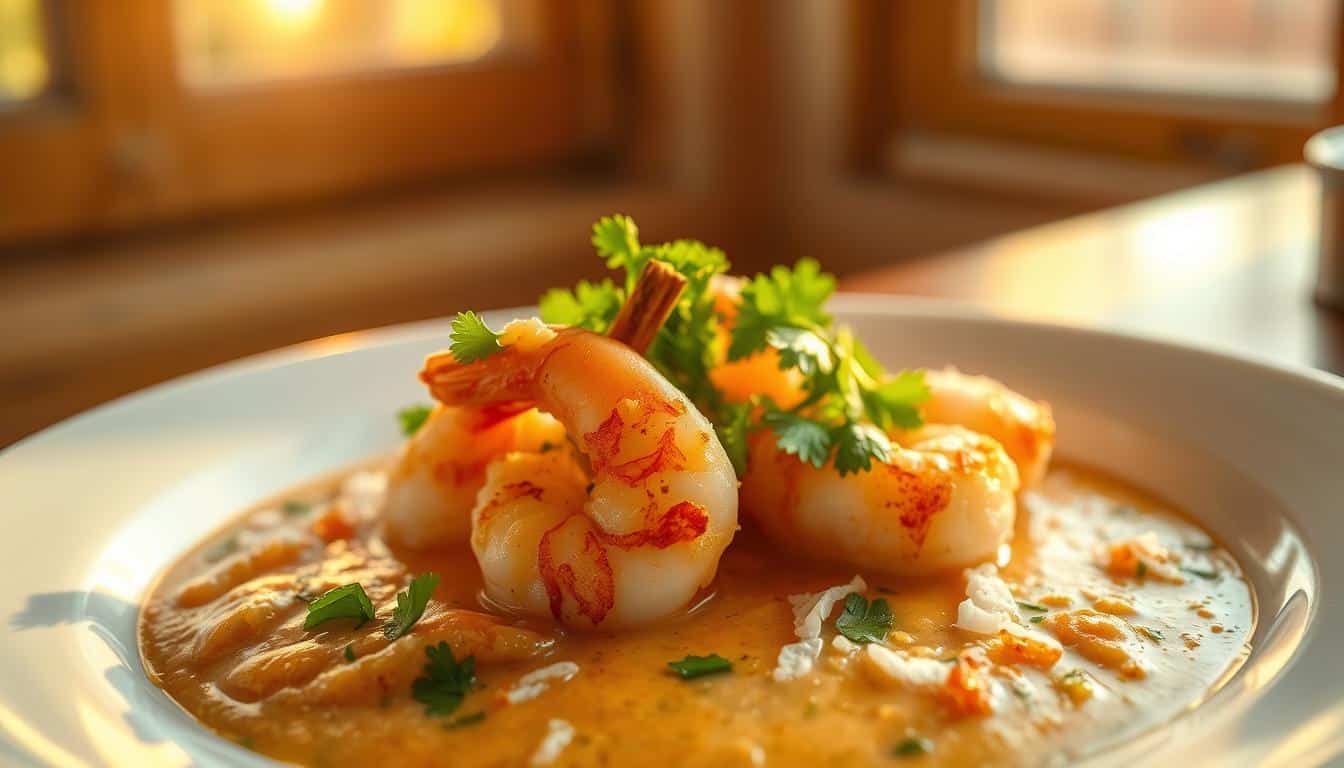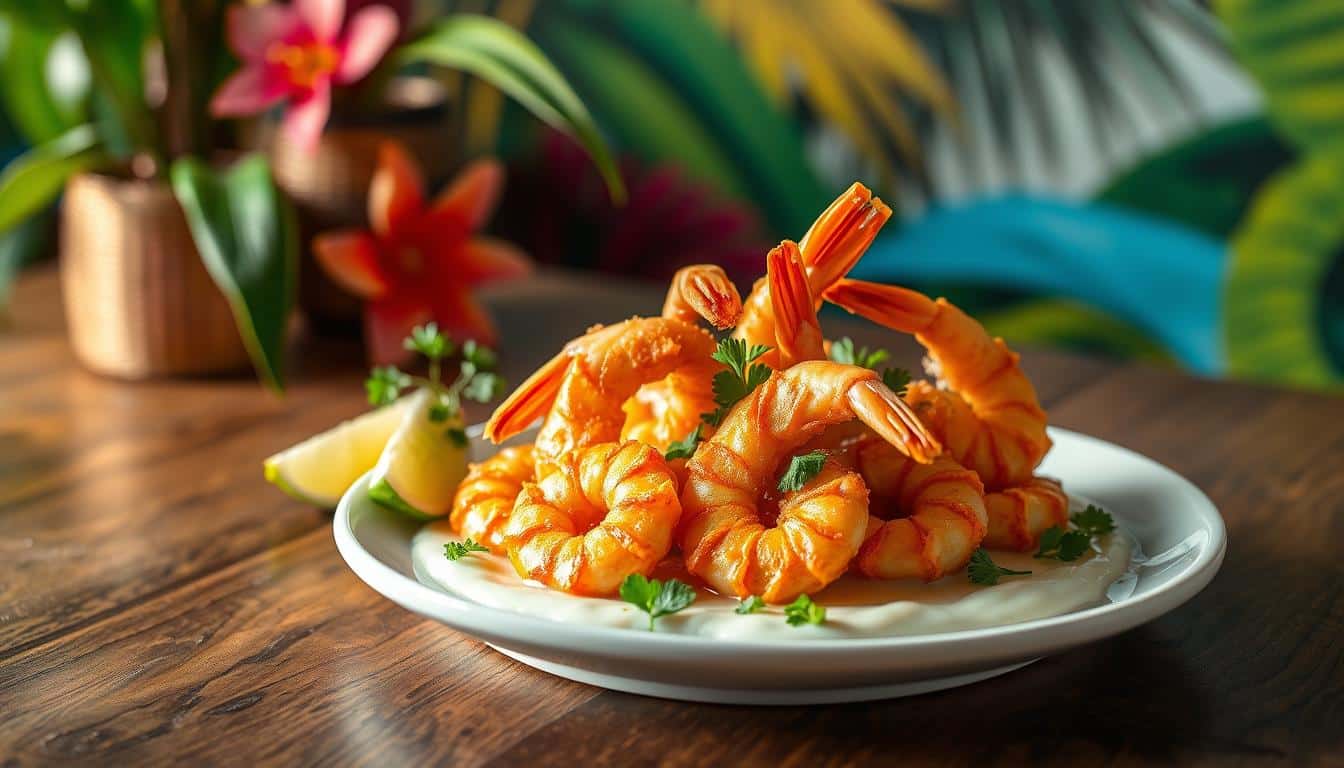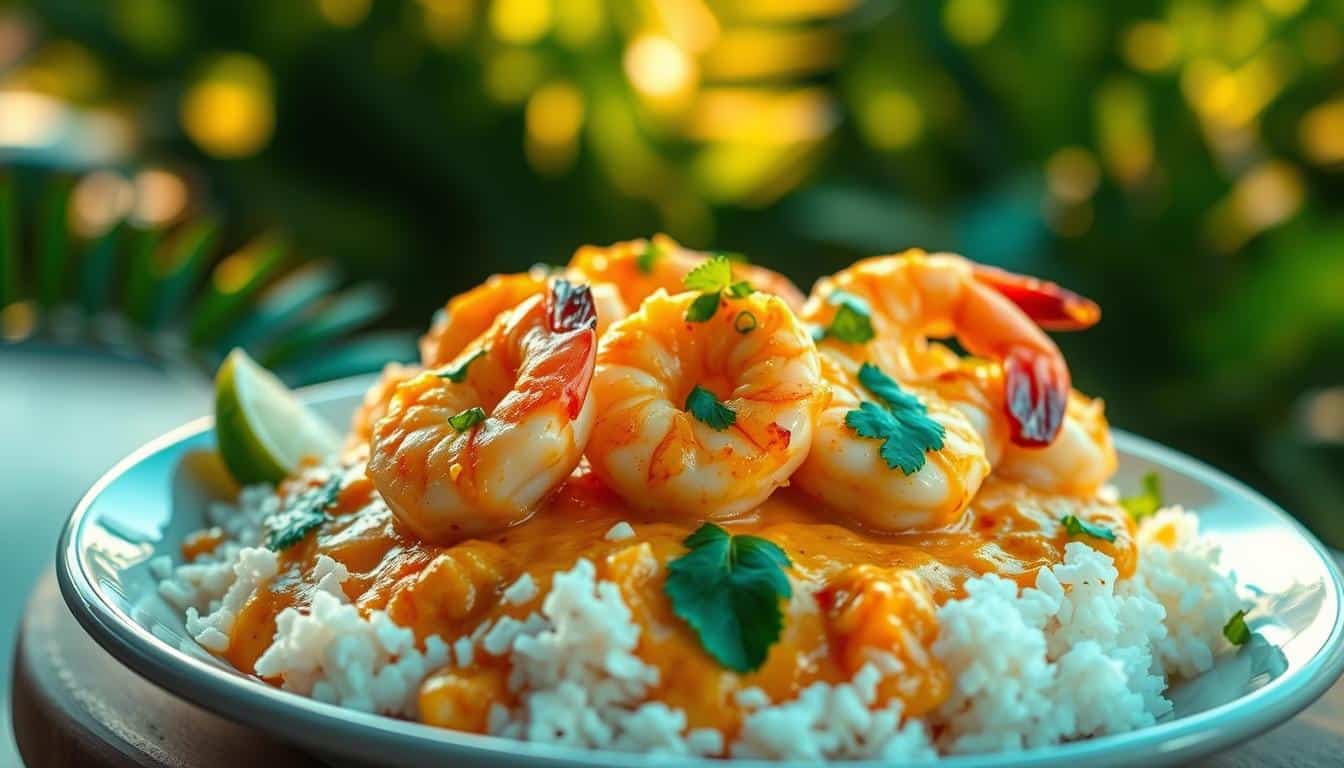Imagine a dish that transports you to a tropical paradise with every bite. Creamy coconut shrimp is more than just a meal—it’s an experience. This recipe combines the succulence of shrimp with the rich, velvety texture of coconut milk, creating a flavor profile that’s both familiar and exotic.
Thank you for reading this post, don't forget to subscribe!
Perfect for a quick weeknight dinner, this one-pan wonder is ready in under 30 minutes. With shrimp as the star, you’ll love how fresh ingredients and aromatic spices come together to create a dish that’s both nourishing and delicious. The sauce, made with red curry and a hint of lime, adds a unique twist that will leave you wanting more.
In this article, we’ll guide you through everything you need to know. From the essential ingredients to step-by-step cooking methods, we’ll show you how to prepare this sensational dish with ease. Whether you’re a seafood lover or just looking for a new recipe to add to your repertoire, creamy coconut shrimp is sure to become a favorite.
Key Takeaways
- Prepares in under 30 minutes, perfect for busy evenings.
- Features shrimp cooked in a rich coconut curry sauce.
- Combines aromatic spices and fresh ingredients for vibrant flavor.
- Covers everything from ingredients to serving suggestions.
- Offers a tropical twist to your usual dinner routine.
Introduction to Creamy Coconut Shrimp
Step into a culinary paradise with creamy coconut shrimp, a dish that blends the sweetness of the tropics with savory flavors. This recipe is a harmonious mix of tender shrimp, aromatic spices, and a rich, velvety sauce that will captivate your taste buds.
What Makes This Recipe Special?
What truly sets this dish apart is its vibrant sauce, crafted with red curry paste, fresh lime juice, and a hint of honey. These ingredients create a balanced flavor profile that’s both tangy and slightly sweet, making every bite irresistible. The addition of red bell peppers adds a pop of color and a subtle crunch, while garlic and fresh ginger infuse the dish with depth.
| Ingredient | Contribution to Flavor |
|---|---|
| Red Curry Paste | Provides a bold, aromatic base |
| Fresh Lime Juice | Adds a tangy freshness |
| Garlic & Ginger | Enhances depth and warmth |
| Red Bell Peppers | Introduces a crunchy texture |
Discover the Tropical Twist
This coconut shrimp recipe is not just a delight to the palate but also a healthier option for a quick weeknight meal. With a cooking time of under 20 minutes, it’s perfect for busy evenings. The sauce, made with coconut milk, simmers to perfection in just a few minutes, delivering complex flavors without the wait.
For those looking to explore more, this recipe offers a tropical twist that’s both nourishing and delicious. Whether you’re a seafood enthusiast or just seeking a new dish to add to your repertoire, this recipe is sure to become a favorite.
Ingredients and Equipment Overview
Your culinary journey begins with fresh, high-quality ingredients and the right kitchen tools. Let’s break down what you’ll need to create this tropical dish.
Fresh Ingredients and Their Benefits
The star of the show is shrimp, packed with protein and low in calories. Coconut milk adds a luxurious creaminess, while garlic and ginger provide a flavorful punch. Red bell peppers contribute a crunchy texture and a burst of color to the dish. Fresh lime juice adds a tangy note, balancing the richness of the coconut milk.
Each ingredient plays a vital role in creating a harmonious flavor profile. The combination ensures your meal is both nourishing and delicious.
Essential Kitchen Tools
A large skillet is your best friend for even cooking. A sharp knife and cutting board are must-haves for preparing your ingredients. These tools make the cooking process smooth and enjoyable, ensuring your dish turns out perfectly every time.
The Creamy Coconut Shrimp Recipe: Step-by-Step
Get ready to craft a dish that’s as flavorful as it is easy to make. This step-by-step guide will walk you through creating a tropical masterpiece that will delight your taste buds.
Sautéing Shrimp and Aromatics
Start by prepping your shrimp. Pat them dry and season with salt and pepper. Heat a large skillet over medium heat and add a tablespoon of oil. Sauté the shrimp until they’re lightly pink, about 2-3 minutes per side. Remove the shrimp and set them aside.
In the same skillet, add another tablespoon of oil. Toss in diced onion, minced garlic, and red bell pepper. Sauté until the vegetables soften, stirring occasionally. This step adds a layer of depth to your dish.
Simmering the Rich Coconut Sauce
Add the Thai red curry paste to the skillet, stirring to combine with the aromatics. Let it cook for about a minute to release its flavors. Pour in a cup of coconut milk, stirring continuously to create a smooth sauce. Bring the mixture to a gentle simmer.
Allow the sauce to thicken for 5-7 minutes, stirring occasionally. If it becomes too thick, you can add a splash more coconut milk. Once the sauce is silky, return the shrimp to the skillet. Warm them in the sauce for another 2-3 minutes to coat evenly.
| Component | Contribution |
|---|---|
| Salt | Enhances flavor and seasons the shrimp |
| Onion | Adds sweetness and texture |
| Paste | Provides aromatic and spicy notes |
| Cup of Coconut Milk | Creates a rich, creamy base |
As you finish cooking, take a moment to appreciate the balance of flavors. The fat from the coconut milk adds richness, while the spices keep it vibrant. Serve your dish hot, garnished with fresh herbs if desired.
For more detailed instructions and variations, check out the full recipe guide to perfect your technique.
Cooking Techniques and Tips
Mastering the art of cooking involves more than just following a recipe. It’s about understanding the techniques that bring out the best in your ingredients. When it comes to creating a delicious and memorable dinner, proper cooking methods are key.
Mastering Sauté and Simmer Methods
Sautéing and simmering are essential techniques that can make or break your dish. Sautéing requires medium-high heat to quickly cook ingredients while preserving their texture and flavor. On the other hand, simmering involves low heat to gently cook your sauce over time, allowing the flavors to meld together.
One of the most important aspects of sautéing is heat control. Too high, and your ingredients might burn; too low, and they’ll steam instead of sear. Aim for a medium-high heat and ensure your pan is hot before adding your protein. This will help create a nice crust on your shrimp, locking in their juices and flavor.
Timing is everything when it comes to cooking protein. Shrimp, for instance, cook quickly—usually within 2-3 minutes per side. Overcooking can make them tough and rubbery, so keep an eye on the clock. Once they’re pink and opaque, they’re done. Remove them from the heat to prevent overcooking, as the residual heat from the pan will finish the job.
When simmering your sauce, patience is a virtue. Let it reduce slowly to thicken and develop a rich, velvety texture. Stir occasionally to prevent sticking, and adjust the heat as needed to maintain a gentle simmer. This process usually takes about 5-7 minutes, depending on the consistency you’re aiming for.
Avoid overcrowding your pan, as this can lower the temperature and lead to uneven cooking. Cook your shrimp in batches if necessary, ensuring each piece has enough space to cook properly. This will help you achieve that perfect sear and prevent the shrimp from steaming instead of sautéing.
Managing ingredient temperatures is another crucial factor. Make sure your protein is at room temperature before cooking to ensure even cooking. Cold ingredients can lower the pan’s temperature, leading to a less-than-desirable texture. Additionally, adding ingredients to the pan in the right order ensures that each component cooks properly without burning or undercooking.
For more tips on perfecting your cooking techniques, check out this guide on mastering sauté and simmer methods. With these expert tips, you’ll be well on your way to creating restaurant-quality meals in the comfort of your own kitchen.
Flavor Enhancers and Substitutions
Elevate your dish with these simple substitutions and enhancers to suit every taste and dietary need. Whether you’re looking for dairy-free options or want to add some extra zest, these tips will help you create a dish that’s truly yours.
Using Coconut Milk and Cream Alternatives
If coconut milk isn’t your preference, don’t worry! You can easily substitute it with heavy cream or cashew cream for a rich, creamy texture. For a dairy-free option, cashew cream is an excellent choice—it’s creamy and has a neutral flavor that won’t overpower your dish. Simply soak cashews in water, blend them with fresh water, and strain for a smooth consistency.
Fresh Herbs and Spices for Extra Zest
Fresh herbs like basil, cilantro, or Thai basil can add a bright, refreshing flavor to your dish. These herbs can be used as a garnish or mixed into the sauce for added depth. For a spicy kick, adjust the amount of red curry paste or add a pinch of chili flakes to suit your taste. Remember, it’s all about balancing the flavors—salt enhances the savory notes, while a squeeze of fresh lime juice adds a tangy touch.
Looking for a creative twist? Try substituting shrimp with tofu, fish, or even chickpeas for a vegetarian option. Each alternative brings a unique texture and flavor, keeping your dish exciting and versatile. For more inspiration, check out this guide on exploring different protein options.
Prep your ingredients the day before to save time during cooking. This way, you can focus on the instructions and enjoy a seamless cooking experience. Whether you’re prepping for a quick meal or a special occasion, these substitutions ensure your dish is both delicious and tailored to your preferences. Garnish with fresh herbs and serve in a bowl for a vibrant, appetizing presentation that’s sure to impress!
Serving Suggestions and Variations
Now that your coconut shrimp is ready, it’s time to think about how to serve it for the best experience. Whether you’re planning a cozy dinner or a festive gathering, the right presentation and sides can elevate your dish to the next level.
Pairing with Rice, Noodles, or Salads
For a classic pairing, try serving your shrimp over a bed of fluffy Jasmine or Basmati rice. The grains soak up the flavorful coconut sauce perfectly, making every bite a delight. Alternatively, toss the shrimp with rice noodles for a lighter, Asian-inspired meal.
If you prefer something fresh, a mixed green salad with a light vinaigrette provides a nice contrast to the rich sauce. Add some sliced bell pepper for a pop of color and extra crunch.
For a creative twist, consider serving the shrimp in tostadas or wrapped in a flour tortilla. This makes for a fun and easy meal that’s perfect for any occasion. Garnish with fresh herbs like basil or a sprinkle of diced bell pepper for added flavor and visual appeal.
Remember, the key is to let the coconut sauce shine while complementing it with sides that enhance its rich, tropical flavor. Experiment with different combinations to find your favorite way to enjoy this dish!

Nutritional Information and Health Benefits
Discover the nutritional benefits of this dish, crafted to be both nourishing and delicious. Each serving offers a balanced mix of protein, healthy fats, and essential nutrients, making it a great option for a wholesome meal.
A single serving contains approximately 250 calories, with about 15 grams of protein and 10 grams of healthy fats. This dish stands out as a healthier alternative to restaurant versions, which often have higher calorie and fat content due to heavy sauces and frying methods.
The use of fresh lime juice adds a burst of vitamin C, while the curry paste contributes antioxidants and anti-inflammatory properties. Oil is used sparingly, ensuring the dish remains light without compromising on flavor. Compared to traditional coconut-based dishes, this recipe uses minimal added fats, keeping it balanced and nutritious.
Portion control is key to enjoying this meal as part of a healthy diet. Pair it with a side of steamed vegetables or a fresh salad for a well-rounded meal. The natural ingredients and light cooking methods make this dish not only tasty but also a great choice for health-conscious individuals.
User Tips for Quick and Easy Meal Prep
Transform your cooking routine with these practical tips for efficient meal preparation. Whether you’re a busy professional or a home cook, these strategies will help you enjoy a delicious meal without the hassle.
Time-Saving Techniques in the Kitchen
Prep ingredients ahead of time to streamline your cooking process. Chop onions, bell peppers, and fresh herbs like basil while your skillet is heating up. This not only saves time but also ensures flavors meld together beautifully.
Consider marinating your protein while you prep. Consider substituting shrimp with fish for a different twist. A quick 10-minute marinade in a mix of lime juice and spices can elevate your dish without extra effort.
Storing, Reheating, and Freezing Guidelines
Store leftovers in an airtight container in the fridge for up to three days. Reheat gently in a skillet with a splash of coconut cream or lime juice to revive the sauce. For convenience, reheat in the microwave with a dash of water to maintain moisture.
If freezing, portion the dish into airtight containers or freezer bags. Thaw overnight in the fridge or reheat directly from frozen in a skillet with added cream for richness. Explore more tips on efficient meal prep in this handy guide.
Mastering the creamy coconut shrimp recipe
Perfecting the art of making coconut shrimp is all about balance and technique. This shrimp recipe thrives on the harmony between flavors and textures, ensuring each bite is both satisfying and delicious.
The process begins with sautéing. Heat a skillet over medium heat and add a touch of oil. Pat the shrimp dry and season lightly. Sear them for 2-3 minutes on each side until pink, then set aside. This step locks in their moisture and flavor.
Next, soften diced onions, garlic, and red bell peppers in the same skillet. These aromatics form the base of your sauce. Stir in red curry paste for depth, then pour in a cup of coconut milk. Let it simmer gently until thickened, about 5-7 minutes, stirring occasionally to prevent sticking.
Return the shrimp to the skillet, coating them in the rich sauce. Cook for another 2-3 minutes to infuse the flavors. Season with a pinch of salt and a squeeze of lime juice for balance. For added creaminess, you can stir in a splash more coconut milk.
Experiment with substitutions like cashew cream or different proteins to make the dish your own. With practice, this shrimp recipe becomes second nature, perfect for any occasion. Its ease and versatility ensure it will be a staple in your kitchen.

Conclusion
And there you have it—a dish that’s as easy to make as it is delicious! This coconut shrimp recipe brings a delightful tropical twist to any meal, with its vibrant flavors and rich, velvety sauce. Whether you’re a seafood lover or just looking for something new, this dish is sure to become a favorite.
The best part? It’s incredibly versatile. Serve it over a bed of fluffy rice, toss it with noodles for a lighter option, or even wrap it in a tortilla for a fun twist. Don’t forget to squeeze a bit of fresh lime juice on top—it adds the perfect tangy touch to balance the richness of the dish.
We hope you’ve enjoyed this culinary journey and are excited to try the recipe yourself. Share your creations with friends and family, and don’t hesitate to experiment with different sides and variations to make it your own. After all, cooking is all about having fun and making memories!
If you’re looking for more inspiration, check out this delicious trout recipe for another flavorful adventure. Happy cooking, and bon appétit!
FAQ
Can I use coconut cream instead of coconut milk for a thicker sauce?
How long does it take to cook the shrimp?
Can I add other protein like chicken or fish to this dish?
How do I prevent the coconut sauce from separating?
Can I make this recipe ahead of time?
What’s the best way to reheat the dish?
Can I serve this with noodles instead of rice?
How can I make this recipe spicier?
Can I use frozen shrimp?
What’s a good garnish for this dish?
Can I make this recipe without garlic?
How do I store leftovers?
Can I use olive oil instead of other oils?
There are no reviews yet. Be the first one to write one.
